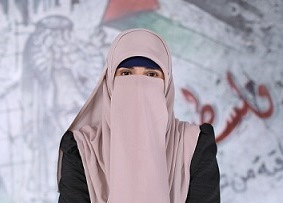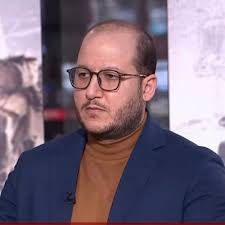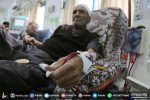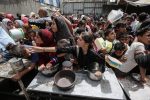In a protest against the deliberate Israeli murders of their colleagues, Ismael Alghoul, and Rami Alrifi, in the Gaza Strip, a group of journalists threw their vests emblazoned with “PRESS” down on the ground before a podium, proclaiming that the supposedly protective attire is useless when the Israeli occupation airstrikes intentionally target media workers, blatantly flouting international law. Ismael Alghoul, an Al Jazeera correspondent, and the cameraman, Rami Alrifi, were assassinated while on duty by the Israeli air raid on their car that was clearly identified and marked as a media vehicle.
Ismael is an incredible loss for Palestine. He was a dedicated and reliable journalist. I contacted him several times for reports from the north and he was always helpful.
A week before his death, I interviewed him about how journalists cope in the north of Gaza amid the continuous Israeli atrocity and starvation war. He told me that people are starving; that many have died in silence from lack of medicine or food without anyone knowing about them, and he impressed upon me the importance of continuing to talk about the famine in the north, because the crisis is ignored and not reported upon in the media. He mentioned that people asked him for food but they did not realize that he was starving like them. The Israeli Occupation army is weaponizing food by closing all the crossings, preventing any international aid to the north. The extremely few trucks which are permitted to cross are just a drop in the ocean of need.
The 27-year-old journalist lived and grew up in Al-Shati’ Refugee Camp. He was father to one little daughter whom he had not seen since the ongoing genocide was unleashed in October. He joined Al Jazeera recently as a Gaza correspondent.
Ismael’s dedication to his craft is evident in his comprehensive field reports, which provide a full picture of the humanitarian situation in Gaza City. His news reports compelled global audiences to confront the harsh realities faced by Palestinians, yet the brutality of the stories he reported on severely impacted him. In a heart-wrenching message sent to one of his friends, Ismael wrote that he is tired of the horrible scenes that he had to cover on a daily basis and that he cannot sleep. The bodies of children and the screams of the injured and their blood-soaked images never leave his mind, and he could no longer endure the sound of children’s voices from beneath the rubble of their destroyed homes.
When I asked him why he would not move to the south and report from there, he said, “I will never leave the north and I will keep reporting the continuous Israeli carnage, even though most journalists left following Israeli orders. I have to live the same way the people live, to feel them, to be able to speak for them. This is what journalism is for.”
His reporting extends far beyond mere coverage – his work serves as a voice of the voiceless, as the north of Gaza Strip is undergoing a media blackout after the Israeli Occupation managed to empty Gaza of most journalists and destroyed the facilities housing many press offices in Gaza City. Throughout Gaza, there is poor access to the internet, particularly affecting the north, leading journalists to take drastic action, sometimes risking their lives by climbing to high areas or on top of buildings for a signal. Without fuel for vehicles to move freely, sometimes they use bicycles. No offices, most reports come from the streets or hospitals. On top of all of these, they report with empty stomachs, starving like everyone else.
In March 2024, Ismael was detained during a raid by the Israeli Occupation forces on Al-Shifa Medical Hospital while he was covering the events. His detention lasted for 12 hours, before he was released. His imprisonment drew widespread condemnation, demanding his immediate release. He told me that the Occupation army confiscated his equipment and phones and burned his vehicle. But he did not give up, fearlessly venturing into danger zones to capture the reality of Israeli aggression using a mobile camera and simple equipment. He continued his work even while facing his own familial tragedies, the death of his father due to lack of medicines, and the martyrdom of his brother.
Palestinian journalists, especially social media influencers, who have been working heroically on empty stomachs and often without electricity to cover the genocide of their people have been exposed not only to murder and detention, but also endure ongoing death threats from Israeli forces. Anas Alsharif, another Al Jazeera correspondent in North Gaza, says he received threatening messages and calls from Israeli soldiers warning him to leave the north, yet he did not evacuate for the sake of continuing his reporting on the atrocity on his people. His home was targeted, murdering his father. Quds Network Director, Sari Mansour, was killed after Israeli aircraft targeted his home. His wife explained to MEMO that he received multiple messages from the Israeli Occupation to stop his live streaming on social media covering Israeli strikes on Palestinian homes, but he refused to stop the media coverage, as it is his right to report. Several journalists, including Motaz Azaiza, who received a warning to evacuate the north and stop coverage, have left Gaza in the face of these death threats.
The record-breaking scale of the killings of journalists in the entire twenty-five mile Gaza Strip exceeds any imagination and any historical precedent. According to the Gaza Media Office, 165 journalists and media workers have been killed in intentional Israeli strikes. Dozens have been massacred along with their families. At least 36 journalists were imprisoned in the Israeli Occupation detention centers.
According to the findings of a collaborative investigation by the non-profit group, Forbidden Stories, which brings together 50 journalists from 13 different news outlets to investigate the targeting of journalists in Gaza, “At least 40 journalists and media workers in Gaza were killed while at home. At least 14 journalists were wearing press vests at the moment they were killed, injured or allegedly targeted. At least 18 journalists were killed, injured or allegedly targeted by drones, and six buildings housing media offices were completely or partially destroyed.”
According to the Palestinian Journalists Syndicate (PJS), around 70 press organizations, including local radio stations, news agencies, transmission towers and journalist training institutes, have been partially or completely destroyed since the beginning of the sweeping assault. The apparent objective of targeting journalists, press facilities and banning the entry of international journalists is to stifle information and prevent the reality of the unfolding massacre from being broadcast to the world. Yet, as many Israeli myths and stories have later been debunked by evidence, many mainstream media organizations now cast doubt on official Israeli narratives, and alternative sources for Palestinian voices have risen to the forefront of global reporting from inside the besieged Gaza Strip.
-Wafa Aludaini is a Gaza-based journalist. Her article appeared in MEMO.











